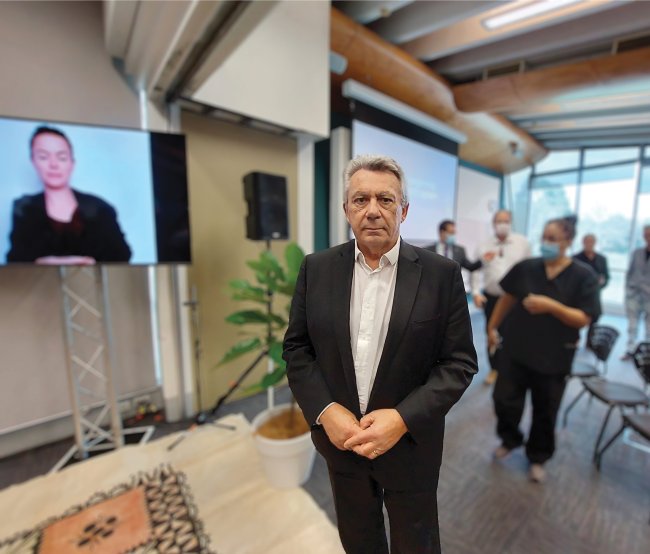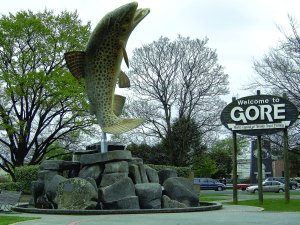Respiratory physician Lutz Beckert considers chronic obstructive pulmonary disease management, including the prevention of COPD, the importance of smoking cessation and pulmonary rehabilitation, and the lifesaving potential of addressing treatable traits. He also discusses the logic of inhaler therapy, moving from single therapy to dual and triple therapy when indicated, as well as other aspects of management
REFORM SHORTS: Short fix of health reform news
REFORM SHORTS: Short fix of health reform news

The first 10 iwi Māori partnership boards are up and running, according to Te Aka Whai Ora.
The agency’s chief executive Riana Manuel provided this snippet of news – and no explanatory details – according to minutes of its first board meeting, held on 1 July.
New Zealand Doctor Rata Aotearoa sought the minutes on 16 August and again on 20 October. The agency sent them, under the Official Information Act, on 8 November by email.
Interim director corporate Craig Owen apologised in a covering letter for the agency not responding to the first request.
“We are looking into this as it is of concern that we do not have a record of your query being received by our agency,” Mr Owen wrote.
Eighteen iwi Māori partnership boards were listed in the Pae Ora (Healthy Futures) Bill, but their names were deleted by the committee of MPs that considered the bill. The committee’s process for establishing the boards was adopted in the Pae Ora (Healthy Futures) Act 2022. It involves the Crown establishing boards by order in council after a potential board has notified Te Aka Whai Ora, and that agency is satisfied the act’s rules have been met.
The purpose of the boards is to represent local Māori views on their health needs and aspirations, how the health system is performing on those, and the design and delivery of services and public health interventions. Boards’ functions include nominating members for the hauora Māori advisory committee.
Te Aka Whai Ora board members were to be briefed on the risk of High Court challenges over the agency’s relationships with iwi Māori partnership boards, according to 29 June meeting minutes of its predecessor board at the interim Māori Health Authority.
The meeting discussed an induction programme for Te Aka Whai Ora members and officials explained this would involve a “legal risk lens”.
Topics would include how independent Te Aka Whai Ora is, what the health minister can and can’t do, the agency’s relationships with Te Whatu Ora, and iwi Māori partnership boards and other Māori organisations.
The role of iwi Māori partnership boards was to be covered, as well as: “Managing conflicts of interest; Potential for judicial review or challenge; Engaging with other iwi, hapū, Māori and whānau organisations.”
Three more localities have been established – in Northland, Southland and Tairāwhiti – making 12 in total so far under the Government’s health reforms.
The Hokonui locality is in Southland. Its partners include the Hokonui Rūnanga, Gore District Council and healthcare providers. They signed a locality charter agreement in October.
In Northland, the locality is in Muriwhenua, the northern part of the Far North district.
The Taikorihi locality in Muriwhenua unveiled its name in the week ending 4 November, says Te Whatu Ora national co-director for localities, Kylie Ormrod, in an email response.
Ms Ormrod provided no further information about the Tairāwhiti locality, except to say that Te Whatu Ora continues to support it. Asked when the 13th and subsequent localities will be unveiled, she said, “No other localities have been announced.”
A theme of a number of interim Māori Health Authority board meetings was its wish for a stronger focus on Te Tiriti o Waitangi, particularly in the interim Government Policy Statement on Health and Te Pae Tata Interim New Zealand Health Plan.
Commenting on a draft of the policy statement in February, the board was concerned it lacked statements on objectives and the expected impacts and outcomes. “[It] is still weakest in the elements that matter to iwi, hapū and Māori.”
Then in April the board “re-asked” for a strengthening of Te Tiriti throughout the Government Policy Statement.
The meeting heard the interim Health Plan was light on indigenising the health system.
“Enabling mana motuhake requires greater breadth as [the plan] focuses more on kāwanatanga and kaitiakitanga rather than mana motuhake and rangatiratanga.”
Addressing pay disparities in healthcare could cost more than $450 million a year, according to interim Health New Zealand board minutes from a discussion on pay parity in primary and community care.
The figure is contained in the minutes of a board meeting held last December that were sought in March and released in October.
Then-director-general of health Ashley Bloomfield told the meeting, chaired by Rob Campbell, of the importance of pay parity “relative to certain areas such as aged care and in achieving the reform aims”.
The minutes indicate board members were given an estimated combined cost of pay equity plus primary care/NGO-secondary care pay parity, but that figure has been redacted from the released minutes. However, the minutes record that the board’s resolutions included: “Note that funding will be required to address pay disparities, which have been estimated in excess of $450 million per year.”
The board meeting of interim Health NZ on 13 May discussed standardising primary care.
The minutes say: “Primary care: Programmes being developed will standardise primary care and deliver more equitable outcomes.
“Nationalisation will increase the reach and quality of services, training pathways, and national consistency. The interim board discussed the need to be critical of the tools used; historically they have exacerbated inequity and the interim board wants to ensure these elements are not replicated in new ways of working.”
We're publishing this article as a FREE READ so it is FREE to read and EASY to share more widely. Please support us and the hard work of our journalists by clicking here and subscribing to our publication and website








![Barbara Fountain, editor of New Zealand Doctor Rata Aotearoa, and Paul Hutchison, GP and senior medical clinician at Tāmaki Health [Image: Simon Maude]](/sites/default/files/styles/thumbnail_cropped_100/public/2025-03/Barbara%20Fountain%2C%20editor%20of%20New%20Zealand%20Doctor%20Rata%20Aotearoa%2C%20and%20Paul%20Hutchison%2C%20GP%20and%20senior%20medical%20clinician%20at%20T%C4%81maki%20Health%20CR%20Simon%20Maude.jpg?itok=-HbQ1EYA)
![Lori Peters, NP and advanced health improvement practitioner at Mahitahi Hauora, and Jasper Nacilla, NP at The Terrace Medical Centre in Wellington [Image: Simon Maude]](/sites/default/files/styles/thumbnail_cropped_100/public/2025-03/2.%20Lori%20Peters%2C%20NP%20and%20advanced%20HIP%20at%20Mahitahi%20Hauora%2C%20and%20Jasper%20Nacilla%2C%20NP%20at%20The%20Terrace%20Medical%20Centre%20in%20Wellington%20CR%20Simon%20Maude.jpg?itok=sUfbsSF1)
![Ministry of Social Development health and disability coordinator Liz Williams, regional health advisors Mary Mojel and Larah Takarangi, and health and disability coordinators Rebecca Staunton and Myint Than Htut [Image: Simon Maude]](/sites/default/files/styles/thumbnail_cropped_100/public/2025-03/3.%20Ministry%20of%20Social%20Development%27s%20Liz%20Williams%2C%20Mary%20Mojel%2C%20Larah%20Takarangi%2C%20Rebecca%20Staunton%20and%20Myint%20Than%20Htut%20CR%20Simon%20Maude.jpg?itok=9ceOujzC)
![Locum GP Helen Fisher, with Te Kuiti Medical Centre NP Bridget Woodney [Image: Simon Maude]](/sites/default/files/styles/thumbnail_cropped_100/public/2025-03/4.%20Locum%20GP%20Helen%20Fisher%2C%20with%20Te%20Kuiti%20Medical%20Centre%20NP%20Bridget%20Woodney%20CR%20Simon%20Maude.jpg?itok=TJeODetm)
![Ruby Faulkner, GPEP2, with David Small, GPEP3 from The Doctors Greenmeadows in Napier [Image: Simon Maude]](/sites/default/files/styles/thumbnail_cropped_100/public/2025-03/5.%20Ruby%20Faulkner%2C%20GPEP2%2C%20with%20David%20Small%2C%20GPEP3%20from%20The%20Doctors%20Greenmeadows%20in%20Napier%20CR%20Simon%20Maude.jpg?itok=B0u4wsIs)
![Rochelle Langton and Libby Thomas, marketing advisors at the Medical Protection Society [Image: Simon Maude]](/sites/default/files/styles/thumbnail_cropped_100/public/2025-03/6.%20Rochelle%20Langton%20and%20Libby%20Thomas%2C%20marketing%20advisors%20at%20the%20Medical%20Protection%20Society%20CR%20Simon%20Maude.jpg?itok=r52_Cf74)
![Specialist GP Lucy Gibberd, medical advisor at MPS, and Zara Bolam, urgent-care specialist at The Nest Health Centre in Inglewood [Image: Simon Maude]](/sites/default/files/styles/thumbnail_cropped_100/public/2025-03/7.%20Specialist%20GP%20Lucy%20Gibberd%2C%20medical%20advisor%20at%20MPS%2C%20and%20Zara%20Bolam%2C%20urgent-care%20specialist%20at%20The%20Nest%20Health%20Centre%20in%20Inglewood%20CR%20Simon%20Maude.jpg?itok=z8eVoBU3)
![Olivia Blackmore and Trudee Sharp, NPs at Gore Health Centre, and Gaylene Hastie, NP at Queenstown Medical Centre [Image: Simon Maude]](/sites/default/files/styles/thumbnail_cropped_100/public/2025-03/8.%20Olivia%20Blackmore%20and%20Trudee%20Sharp%2C%20NPs%20at%20Gore%20Health%20Centre%2C%20and%20Gaylene%20Hastie%2C%20NP%20at%20Queenstown%20Medical%20Centre%20CR%20Simon%20Maude.jpg?itok=Z6u9d0XH)
![Mary Toloa, specialist GP at Porirua and Union Community Health Service in Wellington, Mara Coler, clinical pharmacist at Tū Ora Compass Health, and Bhavna Mistry, specialist GP at Porirua and Union Community Health Service [Image: Simon Maude]](/sites/default/files/styles/thumbnail_cropped_100/public/2025-03/9.%20Mary%20Toloa%2C%20Porirua%20and%20Union%20Community%20Health%20Service%20in%20Wellington%2C%20Mara%20Coler%2C%20T%C5%AB%20Ora%20Compass%20Health%2C%20and%20Bhavna%20Mistry%2C%20PUCHS%20CR%20Simon%20Maude.jpg?itok=kpChr0cc)